


Framed or unframed, desk size to sofa size, printed by us in Arizona and Alabama since 2007. Explore now.
Shorpy is funded by you. Patreon contributors get an ad-free experience.
Learn more.

- Lofty addition
- In 1912
- Keenan Building
- Six years old
- Taken from the P.J. McArdle Roadway?
- It stood only 47 years
- Three track mind
- Incline to the right
- Reach for the sky, 1912 style
- No clean sweep
- Same Job Title, Same Face
- Sadly Lost
- Beautiful ...
- Where you get your kicks
- Aim High
- Pueblo Revival sisters
- Pueblo Neoclassicism
- Milk Man
- Regional dialect.
- Spielberg's inspiration
- Great Photo
- Loaf Story
- Do you still have the Rakes category?
- Could almost be a scene from the 1957 movie 'Hell Drivers'
- The Wages of Fear.
- Conspicuous by their absence
- Got Milk?
- All that aluminum
- No lefties
- Smoke 'em if you've got 'em
Print Emporium
Central Union Station: 1905
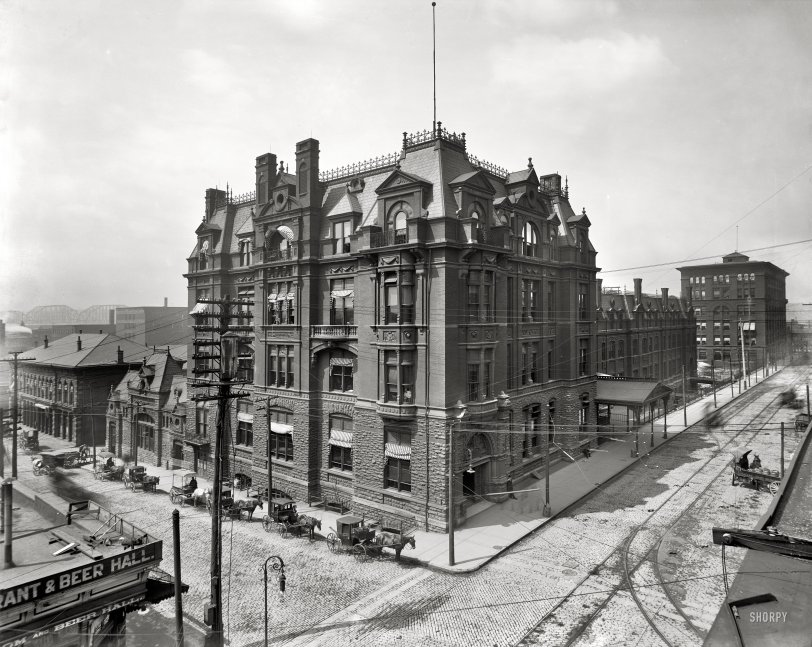
Cincinnati, Ohio, circa 1905. "Central Union Station." You there in the window -- get to work! 8x10 inch glass negative, Detroit Publishing Co. View full size.
Not all it could have been
While not a bad building, it's fairly pedestrian considering it was the most important train station in the city. It's a far cry from the original design by W. W. Boyington of Chicago.
In "The Railroad and the City," Carl Condit writes:
It is unfortunate from the historical and operational as well as the civic standpoints that this impressive design was never built, since the actual work that was begun in the spring of 1882 and opened on 9 April 1883 was inferior to it in formal and spatial characteristics. The headhouse was much reduced in floor area and height ... and the formal treatment of the building was so much inferior to that of the original as to suggest that Boyington's work was redone by the heavy hand of a company architect.
I tend to agree. The original plan has the kind of whimsy and grandeur appropriate for a major railroad station. The one that was built looks like nothing more than a small office building.
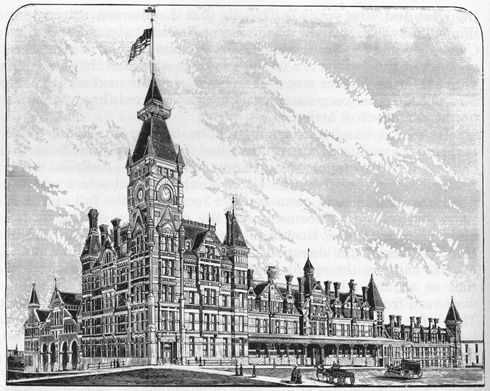
Gothic splendor
The architectural details are breathtaking. Not exactly subtle, I know, but then I've always gone in for overkill. What's worth doing is worth doing well. I could stare at these photos for hours, absorbing the minutiae with reverence and glee.
Horsy parkers
A while back someone on Shorpy wondered how a wagon could be parked squarely against the curb while the horse was parallel to the street. Notice the Lion Brewery wagon in the right foreground is parked in such a manner. The operation is simple, back the wagon straight against the curb and then swing the horse or horses around parallel to traffic. The small front wheels allow this as they can pass under the front of the wagon box and horses can walk sideways when asked to. Farm wagons usually had large front wheels because they were easier to pull on soft ground, plus they would probably not find themselves in a situation where they needed to be parked like this. Take it from an old ice wagon driver as I ought to know. I know about road apples also, but the city (Jackson Tenn) had a high powered street sprinkler truck. "C" cab MACK with solid rubber tires. One used to fill up at the fire hydrant across from my home fairly frequently.
Remnants
Finally, a use for these photos I took a year and a half ago! This station was one of the handful of stations that were replaced by Union Terminal in 1933. The remaining piece of wall still standing is from where the man on the left is leaning, to the awning to the right. The road was obviously widened later.
As for my photos: The first one was taken from a parking lot behind it which was once obviously the basement. The second one is just a close up. The third one is from the same corner as the original, but street level.
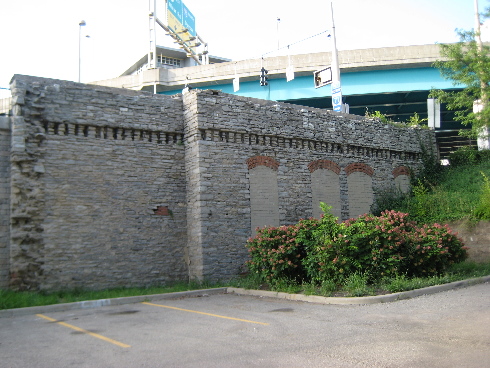
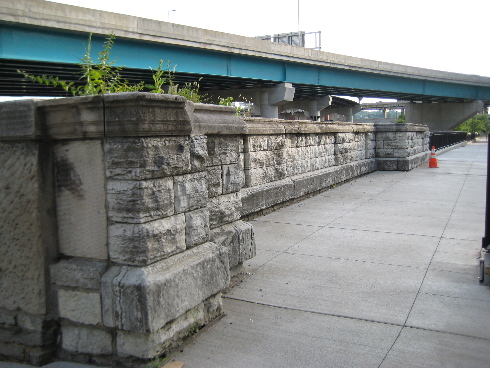

The Addams Hostelry
If Charles Addams had been an Architect, this would have been his style! Wonderful building! Lots of nooks and crannies to enjoy and study.
Lion Brew
That cart load of kegs might come in handy on a Saturday night!
Missing Beer?
Look to the right and you will see a delivery of some keg beer from the Lion Brewery. Must be a strong horse to pull all those kegs. Where are the Clydesdales?
Vestiges
You'd never recognize the neighborhood now (which is made up of parking lots beneath interstate highway viaducts, north of the Bengals' stadium). But if you look carefully from the same angle at the corner of Central Avenue and Third Street, you can see that a piece of the northern facade of the station is still in place: the area between the two 1905 loiterers, from the window sill to the sidewalk.
Automobiles
While enjoying the street scenes of the beginning of the 20th century, I have noticed how quickly the automobile burst upon the scene. It seems that up until about 1905 there were few, if any, autos on the streets. Starting about 1906, there were quite a few. By about 1908, they seem to dominate. I can only wonder how quickly the auto changed the pace of life.
But delicious Lion Beer is on hand
While not Hauck's or Moerlein's beer, the Windisch Muhlhauser "Lion" Brewery seems to be delivering.
The foundations are still there and should be familar to anyone tailgating for a Bengals game:
Pyrotechnics
Unless I am decieving myself visually, there is what appears to be a spent bottle rocket nestled in the inside corner of the two angles on the ledge in the immediate right foreground - on my screen it's just to the left of the SHORPY logo, in the very bottom right corner of the photo.
A forgotten remnant of the last 4th of July parade? Enduring evidence of a mischievious boy?
Also, above it - check out the already-frayed wire draped over the ledge - and above that, the classic knob-and-tube electrical work.
Those were the days! And that's why we have Underwriters Laboratories! Enough buildings burned down and boilers blew up....
Guess I'll head across the street for a beer or three.
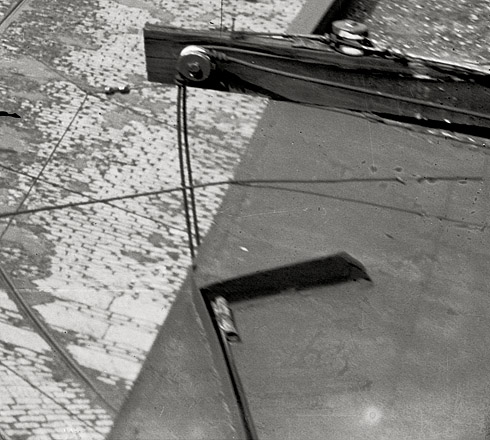
Window treatment
There seems to be more use of curved glass in buildings and even display and curio cabinets in the first half of the 20th century.
That's definitely old Cincinnati.
BEER HALL. All that's missing is a George Hauck or Christian Moerlein sign.
Another Slacker
In the room to the right of the gazer, under the awning, is another unproductive gawker, camouflaged by the dark suit.
The wonder of it all.
I always kind of wonder; "Pardon me, but would you mind if I set up a huge camera and take a picture out of your office window? Shouldn't take but an hour--or two. Oh, and I'll need to open your window and push your desk out of the way."
























On Shorpy:
Today’s Top 5